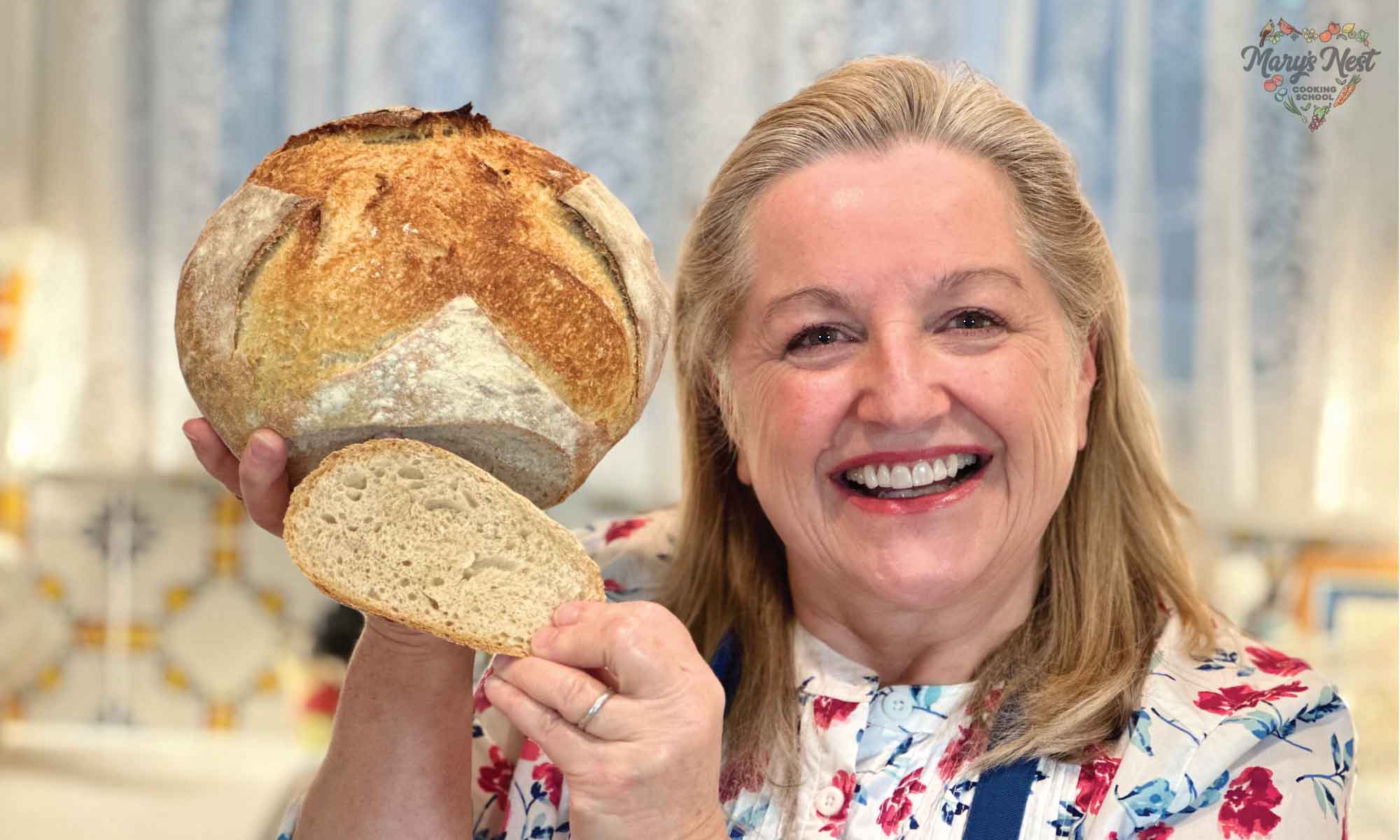How to Make No-Knead Sourdough Bread Using the Stretch and Fold Method
Your folders
Your folders
Prep Time: 90 minutes
Cook Time: 40 minutes
Total: 850 minutes
Servings: 16
Author : Mary's Nest

Ingredients
Export 3 ingredients for grocery delivery
Instructions
Step 1
In a large bowl, whisk the flour and salt together. Set aside.
Step 2
In a large measuring cup, mix the water and sourdough starter together. Whisk well to incorporate.
Step 3
Make a well in the flour salt mixture and pour in the water sourdough starter mixture.
Step 4
Mix the dry ingredients with the wet ingredients until all the dry ingredients are completely saturated and the dough comes together to form a wet sticky dough. This is referred to as a "shaggy" dough.
Step 5
Cover the bowl of dough with a dish towel and set it aside at room temperature for 20 minutes.
Step 6
After 20 minutes, uncover the bowl and complete 5 sets of the stretch and fold method. (See the video to see how to do the stretch-and-fold method.)
Step 7
When all 5 sets of the stretch and fold method are complete, coat the dough in olive oil, cover with a dish towel, set it aside in a room temperature place (away from drafts), and allow the dough to ferment for 12 hours.
Step 8
BAKER'S NOTE: Alternatively, you can cover the bowl with plastic wrap and allow it to rest at room temperature for 1 hour, then transfer it to the refrigerator and allow it to ferment between 18 to 24 hours. Upon removing it from the refrigerator, allow the dough to return to room temperature and then proceed with the remaining steps.
Step 9
After 12 hours, place a piece of parchment paper on a baking sheet or other flat surface and lightly dust the parchment paper with flour. Set aside.
Step 10
Lightly dust a cutting board (or another flat surface) with flour. Uncover the dough, and using a plastic bench scrape or wet hands, remove the dough from the bowl and transfer it to the board.
Step 11
Flatten the dough into a rectangle approximately 8 1/2" x 11". Once flattened, fold the dough into threes as if you were folding a letter.
Step 12
Flip the dough over, and using cupped hands, begin to shape the dough into a ball. (See the recipe video for the technique.)
Step 13
Once the dough is formed into a smooth ball, use the plastic bench scrape to transfer it to the floured parchment paper. Dust the top of the ball lightly with flour and cover it with a dish towel.
Step 14
Allow the ball to rise and double in size. This will take approximately one to two hours.
Step 15
While the ball is rising, place a five to six-quart Dutch oven (with the lid on) onto the middle rack of the oven. Preheat the oven to 500°F (260°C) for at least 30 minutes prior to baking the bread. (Make sure that the knob of the Dutch oven can withstand 500°F [260°C].)
Step 16
Once the ball has doubled in size, use a sharp knife or a baker's lame to score the top of the bread.
Step 17
Using potholders, carefully remove the Dutch oven from the oven and set the Dutch oven on a heatproof surface. Carefully, remove the lid by opening it away from you to avoid exposure to the steam. Set the lid on a heatproof surface.
Step 18
Using the corners of the parchment paper, lift up the ball and transfer it, along with the parchment paper, down into the Dutch oven. (Be careful because the Dutch oven will be hot.) Using a potholder, replace the lid onto the Dutch oven and make sure that all the parchment paper is tucked into the Dutch oven.
Step 19
Using potholders, transfer the Dutch oven back onto the middle rack of the oven, close the oven door, and lower the oven heat to 475°F (246°C). Bake the bread, covered for approximately 30 minutes.
Step 20
After 30 minutes, open the oven door, and using a potholder, carefully remove the lid of the Dutch oven and place it on a heatproof surface. Close the oven door and allow the bread to continue to bake until it is a golden brown on top. This can take anywhere from five to fifteen minutes but watch it closely. You do not want it to burn.
Step 21
Once the bread is a golden brown on top, turn the oven off, and using potholders, remove the Dutch oven from the oven and place it on a heatproof surface.
Step 22
Once the parchment paper has cooled, use the ends of the paper to lift the bread out of the Dutch oven and transfer it (along with the parchment paper) to a cooling rack.
Step 23
Once the bread has cooled a bit and you are able to touch it, tap the bottom of the bread. It should sound hollow. This indicates that the bread has baked sufficiently.
Step 24
Remove the parchment paper and allow the bread to continue to cool on the cooling rack.
Step 25
Once the bread has cooled, use a serrated knife to slice it.
Step 26
Sourdough bread is best stored at room temperature in a bread bag or a bread box. It should stay fresh for approximately five days.